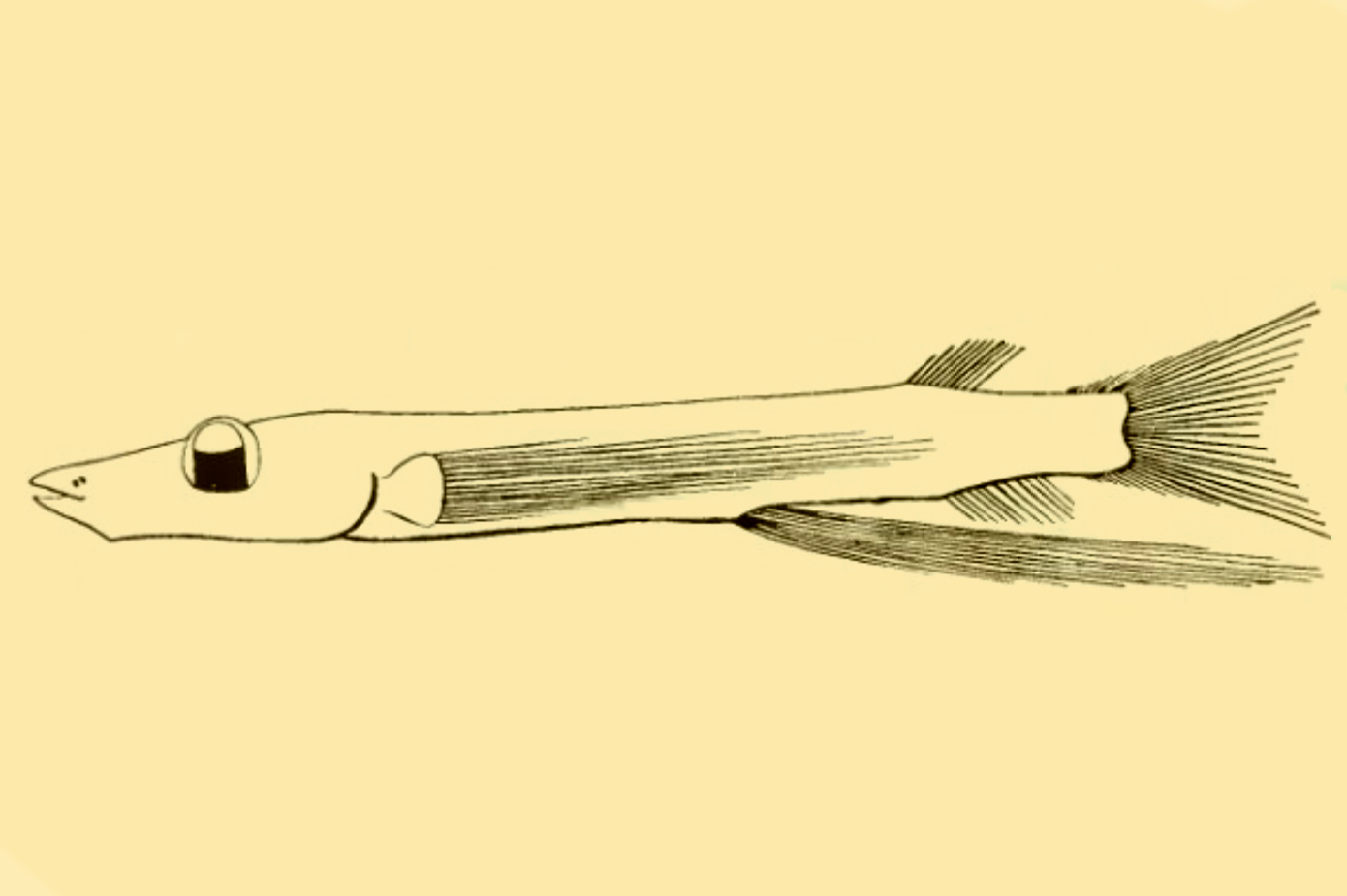Dolichopteryx anascopa Brauer 1901

Illustration of the holotype of the spookfish Dolichopteryx anascopa. Source: Brauer 1906 Die Tiefsee-Fische. I. Systematischer Teil "Valdivia" 1898-1899. License: Copyright expired
Summary:
A species of Dolichopteryx with tubular eyes protruding anterodorsally, an oval opaque layer apparent on the ventral aspect, anal fin originating under the dorsal fin, pelvic fins inserted at about 3/5 SL, the anus anterior to the dorsal-fin base, elongate pectoral- and pelvic-fin rays, an adipose fin, 31–32 (= 8+1 + 22–23) gill rakers and 43 vertebrae.
Cite this page as:
Dianne J. Bray, Dolichopteryx anascopa in Fishes of Australia, accessed 27 Jun 2025, https://fishesofaustralia.net.au/Home/species/5141
Dolichopteryx anascopa Brauer 1901
More Info
|
Distribution |
Known only from west of Cocos (Keeling) Islands, Indian Ocean (holotype, ZMB 17428) inside the Australian EEZ, and south of the Suruga Seamount, west Mariana Ridge, western North Pacific (NSMT-P 95484). The holotype was collected between the surface and a depth of 2400 m, and the second specimen between 0-503 m. |
|
Features |
Species in the genus Dolichopteryx have two parts to the eye, and use both refractive and reflective optics. The telescopic eye has a traditional lens to focus images, and a swelling called a diverticulum or "second eye". This second eye reflects light and focuses it onto the retina via a curved mirror-like structure of tiny plates probably comprised of guanine crystals, arranged into a multi-layer stack. The plates within the mirror's curved surface are precisely orientated to focus reflected light on to the retina. Scientists hypothesize that the 'traditional' eye helps detect objects silhouetted against the faint downwelling light from above, The diverticulum, however, which is superior in gathering light, enables the fish to detect bioluminescent flashes from animals in the surrounding water. See Wagner et al. (2013) for further information. |
|
Colour |
From Mizusawa et al. 2015: just after collection, overall whitish, slightly reddish on hypaxial region and gut anterior and posterior, respectively, to insertion of pelvic-fin; two longitudinal black rows of melanophores close to midlateral line on both epaxial and hypaxial portions of trunk and tail. In preservative: melanophore patterns—several melanophores below nostrils and behind upper jaw, a feeble line from articular region to below eye along ventral margin of operculum, epaxial row from just before a vertical line from insertion of pelvic-fin base to caudal peduncle, hypaxial row from just after insertion of pectoral-fin base to caudal peduncle (hypaxial row more conspicuous than epaxial), three melanophores laterally on gut, 24 along midlateral line of ventral cleavage; melanophores also present on anal-fin base, outer surfaces of stalked base of pectoral fin, proximal parts of pectoral- and pelvic-fin membranes, and caudal-fin base (dorsal and ventral margins). |
|
Remarks |
Parin (2005) considered Dolichopteryx anascopa to be a junior synonym of D. trunovi. |
|
Species Citation |
Dolichopteryx anascopa Brauer, 1901, Sitzungsberichte der Gesellschaft zur Beförderung der Gesamten Naturwissenschaften du Marburg 8: 127. Type locality: west of Cocos Islands, Indian Ocean, Valdivia station 182, 10°08'02"S, 97°14'09"E, depth 2400 m. |
|
Author |
Dianne J. Bray |
Dolichopteryx anascopa Brauer 1901
References
Brauer, A. 1901. Über einige von der Valdivia-Expedition gesammelten Tiefseefische und ihre Augen. Sitzungsberichte der Gesellschaft zur Beförderung der Gesamten Naturwissenschaften du Marburg 8: 115-130 figs 1-3
Brauer, A. 1906. Die Tiefsee-Fische. I. Systematischer Teil. In: Chun, C. (ed.) Wissenschaftl. Ergebnisse der deutschen Tiefsee-Expedition "Valdivia", 1898–99. Jena Tiefsee-Fische 15: 1–432, pls 1–18 (illustrated - p. 24, Fig. 4) PDF
Fukui, A. & Kitagawa, Y. 2006. Dolichopteryx minuscula, a new species of spookfish (Argentinoidei: Opisthoproctidae) from the Indo-West Pacific. Icthyological Research 53(1): 113-120.
Hartel, K. 2010. Dolichopteryx anascopa. The IUCN Red List of Threatened Species. Version 2014.3.
Parin, N.V. 2005. Dolichopteryx trunovi sp. nova - a new replacement name for D. anascopa (nec Brauer, 1901) Trunov, 1997 (Opisthoproctidae, Argentinoidea). Journal of Ichthyology 45(1): 132-133.
Wagner, H.J., Douglas, R.H., Frank, T.M., Roberts, N.W. & Partridge, J.C. 2009. A Novel Vertebrate Eye Using Both Refractive and Reflective Optics.Current Biology 19(2): 108–114. DOI:http://dx.doi.org/10.1016/j.cub.2008.11.061

